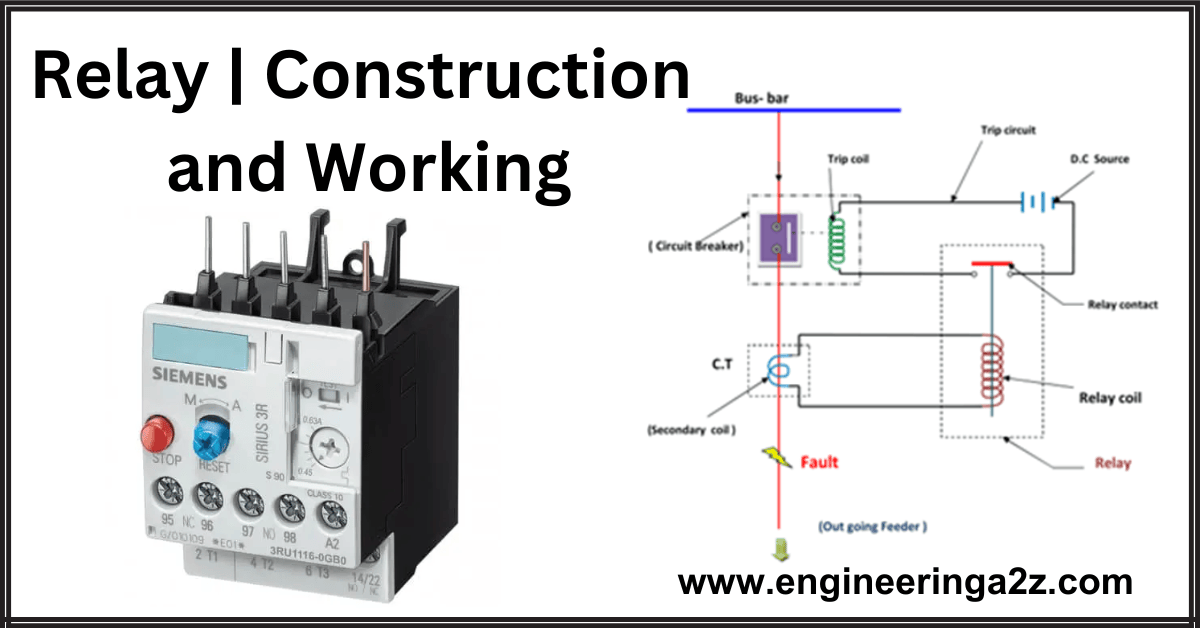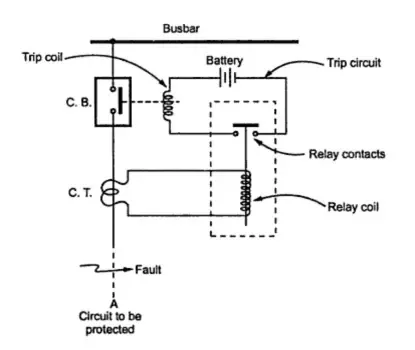
Table of Contents
Relay
A relay is a protective device that basically detects the fault in a transmission line and it gives signal to the circuit breaker to initiate the operation so that it can isolate the defective element from the rest of the system.
In an electrical circuit, basically relay measures the abnormal condition of the circuit by constantly measuring the electrical quantities which are different under normal and abnormal conditions. The quantities which may change under abnormal or faulty conditions are current, voltage, frequency, and phase angle. Whenever the fault is detected by the relay, the relay operates to close the trip circuit of the circuit breaker which lead to the opening of the circuit breaker and disconnection of the faulty circuit from the rest of the circuit.
Construction of Relay
The basic relay circuit diagram is shown in the figure.

This diagram basically represents one single phase of the three-phase system for easy understanding of various connections. The relay circuit diagram can be further divided into 3 parts for easy understanding are:
Part 1 Which is the first part basically it consist of the primary winding of the current transformer which is in series connected with the line to be protected.
Part 2 Which is the second part which basically consisting the relay operating coil and the secondary winding of the current transformer.
Part 3 Which is basically the tripping circuit which may be either AC or DC. It consists mainly of the relay stationary contact, the trip coil of the circuit breaker, and of course the source of the supply.
Working of Relay
Whenever a faulty condition occurs in a circuit say a short circuit has occur at point f (refer to the diagram) on the transmission line. This will lead to heavy current flow in the line. This heavy current flow which passing through the relay coil will lead to the operation of the relay coil causing the relay coil to operate by closing its contact.
Now this also closes the trip circuit of the circuit breaker which will lead to the opening of the circuit breaker and hence isolating the faulty part from the rest of the power system. This is how basically a relay works for the protection of the system without damaging the equipment by isolating the faulty portion of the system.
Fundamental Requirement or the Qualities of the Protecting Relay
The main function or we can say the principle function of the protective relay is to remove the element of the power system which starts to operate in an abnormal condition or the element which is interfacing with the healthy portion of the power system. For the satisfactorily working of the protective relay, it should have the following functions:
- Selectivity
- Speed
- Sensitivity
- Reliability
- Simplicity
- Economy
1. Selectivity
The potential of the protective system is to select correctly the part of the system which is under faulty condition and to detach from the healthy system without interrupting the rest of the system.
2. Speed
The relay should react as soon as there is faulty condition and discount the system for the following reasons
- Carrying faulty current for a longer duration of time may lead to damage to the electrical apparatus
- System voltage decreases greatly if a failure occurs in the system. If the abnormal section is not disconnected as soon as possible then it may shut down the consumer motor and generator due to the low voltage which is being created by the fault and the system will become unstable
- The higher is the speed of the relay the lower is the possibility of the development of one type of fault into further more severe type
3. Sensitivity
The potential of the relay system to operate with lower values of the actuating quantity.
4. Reliability
The potential of the relay system to work under pre-determined conditions. The absence of reliability in the protection system would provide large effectiveness and could even become a liability for the system.
5. Simplicity
The relay protecting system should be pretty much simple so that it can be easily maintained. More the simpler the system the greater will be its reliability. Reliability and simplicity are closely interrelated to each other.
6. Economy
The economic aspect is the most important factor in the choice of a particular protection scheme. Sometimes a compromise method has to be adopted when it is uneconomically justified to use an ideal scheme for protection purposes. As per the rule, the protective gear should not cost more than 5% of the total cost.
Frequently Asked Questions (FAQs)
What is a relay?
A relay is an electrical device that switches on or off a circuit by opening or closing contacts in response to a signal.
How does a relay work?
A relay works by using an electromagnet to pull a set of contacts together or push them apart. When an electrical current is applied to the coil of the electromagnet, it creates a magnetic field that either attracts or repels the contacts, causing them to open or close.
What are the types of relays?
There are many types of relays, including electromagnetic relays, solid-state relays, thermal relays, reed relays, latching relays, buchholz relay, and overload relays.
What are some common applications of relays?
Relays are used in a wide range of applications, including in automation, motor control, lighting control, HVAC systems, and security systems, to name a few.
Read Also :
- Buchholz Relay | Working Principle of Buchholz Relay
- Balanced Earth-fault Protection
- Protection Schemes Of Switchgear
- Circuit Breaker | Types of Circuit Breaker





Leave a Reply